Last Updated on September 14, 2023
Describing people’s appearance in German is difficult types of essay. You should, firstly, know the appropriate words, and secondly, correlate these words with the appearance of a person. At best, people are able to name eye color, hair color, hair length, and eye/mouth size. It is no less difficult in this type of essay to preserve a variety of sentence structures. It is clear that without training it will be a continuous “he has …”
The first part is about the basic principles of describing people’s appearance in German. An example of possible assessment by the teacher and adjectives for different parts of the head are given.
Part 2 Describe appearance of a person in German. Body and clothing
Part 3 Description of a person’s appearance in German. 3. How to avoid repetition in essay
About myself in German – sich vorstellen
German picture description phrases and sequence
Giving direction essay in German. Wegbeschreibung
Dialogues b1 Deutsch Test für Zuwanderer
German dialogues b1 for Deutschtest für Zuwanderer. Part 2
There are two types of description of a person – a description of appearance and characteristics. The description of appearance assumes only appearance and nothing more. Nobody cares about your opinion about this person, you just have to tell what you see. The description also writes what a person thinks and feels.
Essay assessment criteria – describing people’s appearance in German school (Personenbeschreibung)
Points are approximate, this is one of the assessment versions. The teacher can give points at his own discretion. But the general principles that make up the assessment are clear.
- presence of all parts (one point per part)
- complete sentences
- logic (do not mix eyes with lips) (3 points)
- the correctness of the description (correct use of words – do not call a brunette a blond) (2 points)
- essay written in present tense (2 points)
- various beginnings of sentences (up to 6 points)
- use of different verbs (up to 6 points)
- precise and different adjectives (up to 4 points)
- errors (up to 4 points)
- good layout and structure (2 points)
Sequence of describing
As we can already see from the criteria, in describing people’s appearance in German it is important to follow the logic of describing.
The standard sequence that all beginners should follow is from top to bottom:
- who is this (age, gender)
- head, ears, hair,
- forehead, eyebrows, eyes,
- nose, cheeks,
- mouth, chin,
- neck, body,
- clothes.
There may be a slight change in sequence or the omission of unimpressive parts, but there is no need to jump up and down the face.
Those who are fluent in writing can try the describing from the general to the specific: the figure, the clothes, then the details. It is more difficult to keep logic in this describing, but it can turn out to be more natural, more artistic.
Who is this
First we need to determine who a person is by gender and age. If you remember not only a man and a woman or a boy and a girl, then this indicates your developed vocabulary.
Let’s start with the younger ones:
- das Baby
- der Säuling (first year of life)
- das kleine Kind, das Kleinkind
- das Kindergartenkind
- der Junge
- das Mädchen
- der Schüler
- die Schülerin
- das Schulkind
- der Teenager (for some reason more often about girls)
- der / die Halbwüchsige (adolescent, less common)
- der / die Jugendliche (adolescent, often)
- der (junge) Mann
- die (junge) Frau
- der / die Erwachsene
- der Rentner, der Senior
- die Rentnerin, die Seniorin
- der / die Hochbetagte (aged)
- der / die Alte (the old man)
- der alte Mann
About Hochbetagte and other similar words
Age words

Head (der Kopf)
Hair (Haare)
Hair color
Do not forget that any color can be refined by adding at least dunkel or hell. To avoid repeating the word hat, adjectives can be used: Er ist rothaarig.
schlohweiß – snow-white
Strähne – strands, in this way, gesträhnt – with strands

Hair feature
Hair can be:
– different to the degree of curlyness (according to my feelings, kraus is the most curly, then lockig, then wellig)
– by density (schütter – rare)
– according to grooming and health (zerstaust – disheveled, struppig – shaggy)

Hairstyle
The hairstyle can be characterized by:
by lenght
by the way (not) tied hair
parting

Now let’s look at the examples

Face (das Gesicht)
We can describe the face:
– according to the form
– according to the color and quality of the skin
Form:
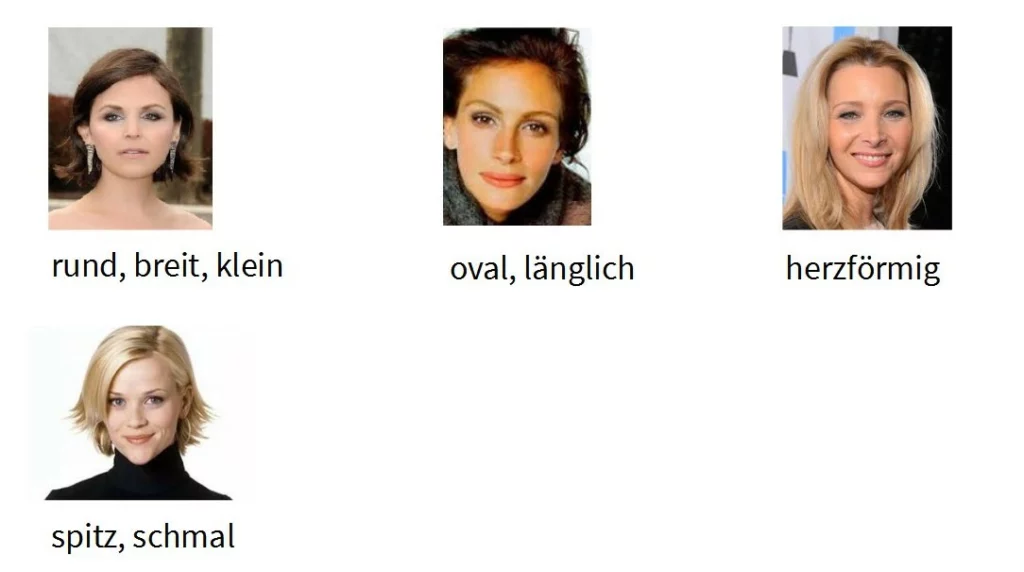
Skin (die Haut)
das Grübchen – dimple
die Sommersprossen – freckles
die Falte – wrinkles
das Muttermal – nevus
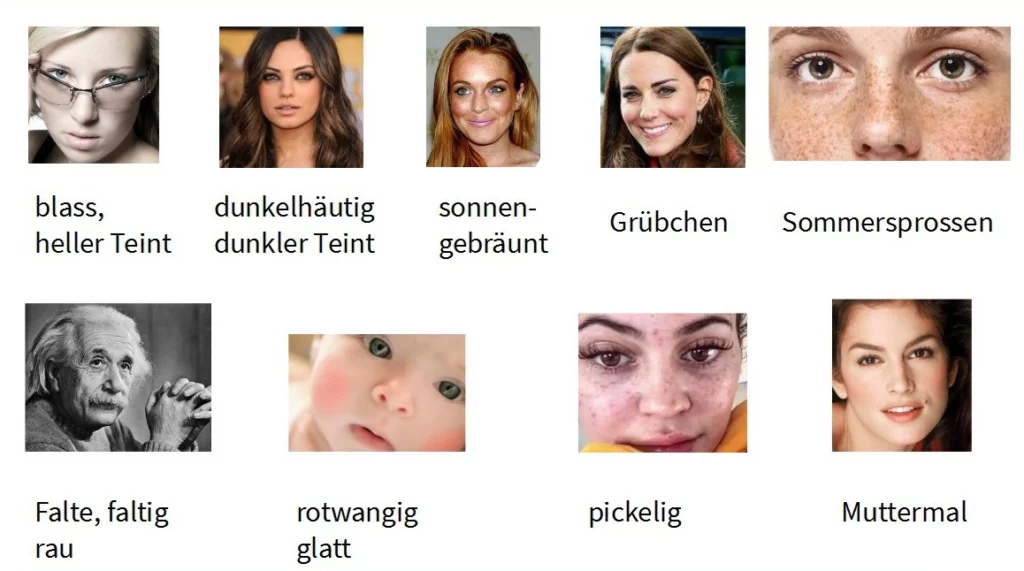
Ears (das Ohr)
It is rarely possible to describe the ears, since they are mostly hidden behind the hair. You can see the size. Sometimes they stick out.
klein, groß
verdeckt
abstehend, anliegend
Segelohren
Do not forget to describe the earrings, if any (Ohrringe).
Forehead (die Stirn)
The forehead is also not the most convenient object. If we see a face in front, then we can describe the size. The side view makes it possible to describe the form.
hoch
niedrig
flach, gewolbt
fliehend (sloping)
Eyebrows (die Augenbraue)
Eyebrows are different:
– by density (buschig – thick, bushy, gezupft – plucked)
– in shape (hervorstehend – protruding, geschwungen – as arc, gebogen – bent)
– by color
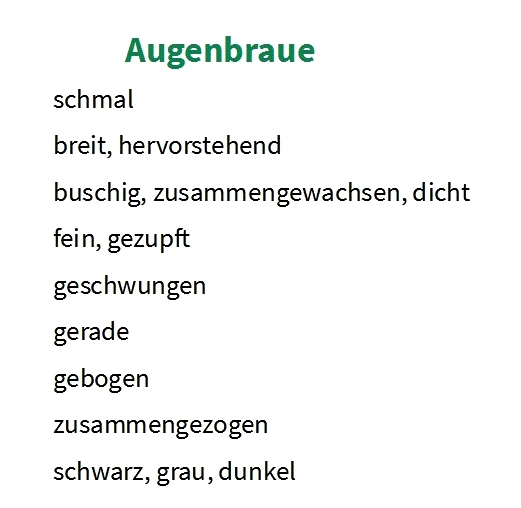
Eyes (das Auge)
We characterize the eyes:
– to size
– to form
– to color
– by “behavior” (schielend – cross-eyed, zusammengekniffene – squinted, hervorquellende – protruding)
Don’t forget to describe the glasses (Brille), if any.
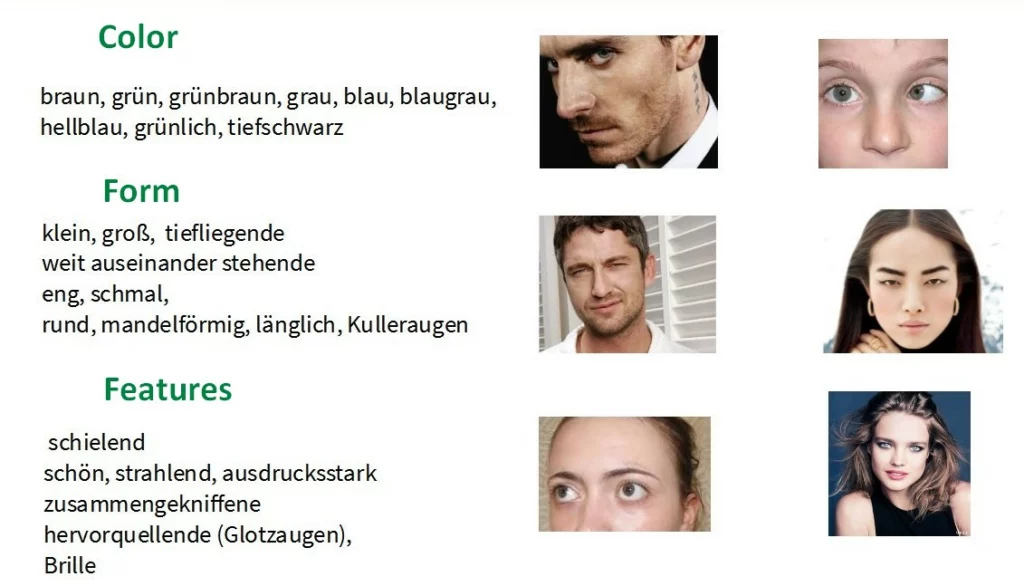
If they say something about eyelashes (Wimpern), then this is the length and density:
kurz, lang, dicht
Nose, cheeks, chin (die Nase, die Backe, das Kinn)
The nose can:
– be big – small, long – short
– have a special shape: bulbous – sharp or hooked, Roman nose – snub-nosed, crooked – straight
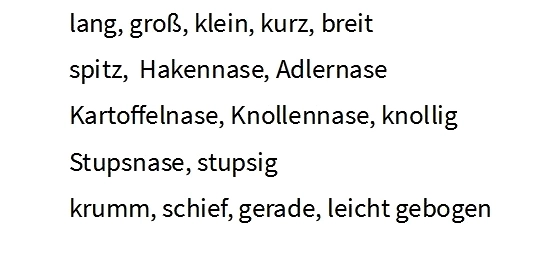
Cheeks are characterized by color and fullness. Chin – by how much it protrudes, and by shape.
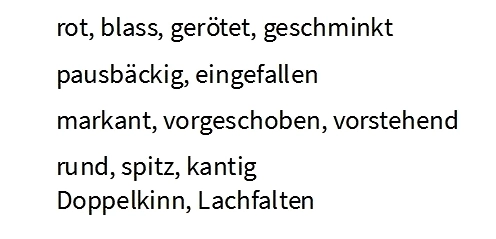
Let’s look at the photographs of the noses and cheeks.
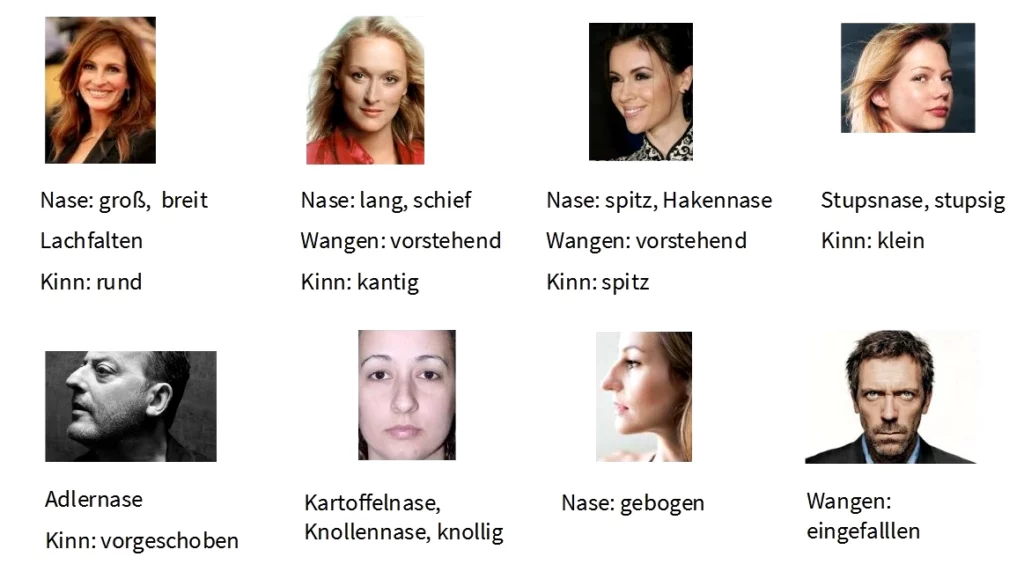
Mouth, lips, teeth (der Mund, die Lippen, die Zähne)
Thickness, width, color and “behavior” are the characteristics of the lips.
wulstig – bulging, thick
zusammengepresst – compressed
verkniffen – pursed lips as an expression of bitterness or anger
geschwollen – swollen
verschmitzt – cunning, slyly smiling
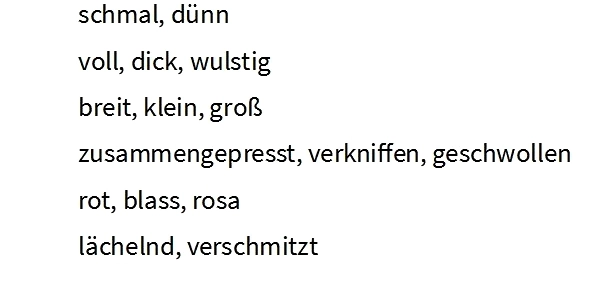
It doesn’t always come to the teeth – they are often not visible.
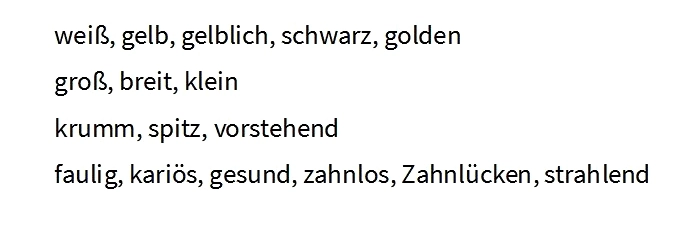
Beard, sideburns
Finally, we get to the extra hair and neck. The bald head also got here, although it, of course, refers to the hair.
Quite a lot can be said about male vegetation:
– how overgrown (smooth, three-day stubble, beard…)
– beard size and shape (Kinnbart, Ziegenbart)
– mustache: size, shape, density (Schnurrbart, Oberlippenbart)
– the sideburns

Neck (der Hals)
Even if it is visible, you can’t say much about it:
lang, kurz, schmal, breit
To be continued:
Describe appearance of a person in German. Body and clothing
Description of a person’s appearance in German. 3. How to avoid repetition in essay
Do you enjoy the site without cookies and maybe without ads? This means that I work for you at my own expense.
Perhaps you would like to support my work here.
Or Cookie settings change: round sign bottom left
